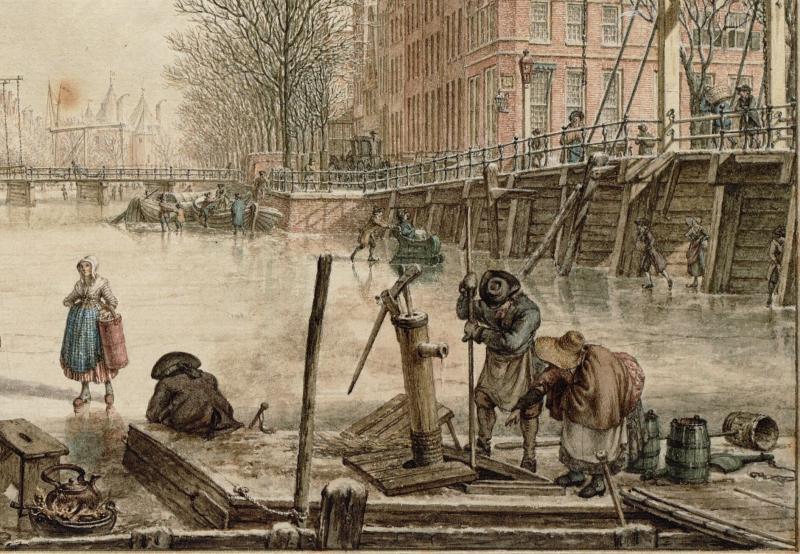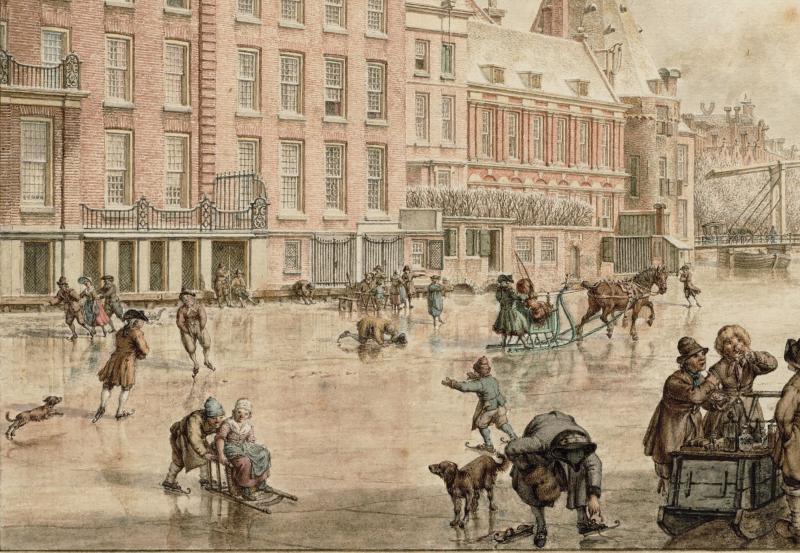In January 1763, chronicler Jacob Bicker Raije wrote that the ice in Amsterdam that winter was so thick that even the icebreaker could not sail. “Fresh water is so scarce that [prices rise] and water has to be brought in by sledge and horse from Muiden and Weesp. Many people use the ice from the IJ [(estuary)], Amstel [(brackish river)], and even the canals, which causes many illnesses.”

Figure 1. Two people inspect a frozen floating water container that held clean drinking water. Detail of Jacob Cats, Amstel. Gezigt van de kom, tusschen de Doelestraat en de Halvemaan’s Brug, 1783.
Figure 1. Two people inspect a frozen floating water container that held clean drinking water. Detail of Jacob Cats, Amstel. Gezigt van de kom, tusschen de Doelestraat en de Halvemaan’s Brug, 1783.
Detail from painting by Jacob Cats, 1783.
Courtesy of Stadsarchief Amsterdam, Collectie Atlas Splitgerber, 010001000798. Click here to view source.
 This work is licensed under a Creative Commons Public Domain Mark 1.0 License.
This work is licensed under a Creative Commons Public Domain Mark 1.0 License.
As a result of the relatively colder climate regime that we have come to know as “the Little Ice Age,” the Dutch Republic endured severer winters in the early modern period. In its western province of Holland, where most vital transport infrastructure was water-based and the winter temperature lingered around freezing point, the Little Ice Age’s average one-degree difference in temperature compared to the twentieth century could mean the waterways froze for weeks or even months—rather than a few days a year. In this contribution, I consider some of the effects of the seasonal transformation of water to ice as they relate to mobility. By looking at frozen waterways and drinking water, I seek to show how mobility is a fruitful framework for environmental histories even before the fossil-fuel-powered mobility revolutions.

Slipping and sliding—mobility on the frozen Amstel. Detail from Jacob Cats, Gezigt van de kom, tusschen de Doelestraat en de Halvemaan’s Brug, 1783.
Slipping and sliding—mobility on the frozen Amstel. Detail from Jacob Cats, Gezigt van de kom, tusschen de Doelestraat en de Halvemaan’s Brug, 1783.
Detail from painting by Jacob Cats, 1783.
Courtesy of Stadsarchief Amsterdam, Collectie Atlas Splitgerber, 010001000798. Click here to view source.
 This work is licensed under a Creative Commons Public Domain Mark 1.0 License.
This work is licensed under a Creative Commons Public Domain Mark 1.0 License.
Access to drinking water became a problem in harsh winters. Keeping water unfrozen and pumps working was a substantial effort, requiring a great deal of labor and fuel. While many other early modern European cities were serviced by wells and rivers, many cities in coastal Holland had their drinking water supplied by means of rainwater cisterns and imported surface water because the local surface and ground water was too brackish to drink. Mobility thus plays an important role here: in Amsterdam, surface water had to be imported from further upstream by barges, as there was no conduit or aqueduct. This barge-imported water was also used to fill cisterns in severe winters. The Amsterdam brewers together maintained a horse-pulled icebreaker to break open the ice in the winter and secure the route upstream to good water. Yet, while water selling has previously been described mostly as a side activity of these brewers, notarial deeds show a larger industry of water sellers who kept staff and sold water by the bucket from floating wooden containers in the canals: in 1765, water seller Trijntje van Rosmalen was busy freeing her water container from ice with three additional people (see also Figure 1), when she was bothered by the son of a water importer that she had previously bought her water from (she now bought her water from another importer). The notarial deposition shows water imports were a larger industry and infrastructure than merely a brewers’ side activity—and that ice and frost presented significant challenges to it.
While harsh winters disrupted mobility and could cause scarcity of drinking water, snow and ice also brought along new types of mobility and heralded a “slipping and sliding society”—that could be both leisurely and lethal. In Amsterdam, seventeenth-century regulations against nuisance from snow sleds drawn by horses show that the strict management of vehicular speed in the city was uniquely challenged by the ease of speeding in the snow or on the ice. Bicker Raije wrote in January 1771 that “as it has snowed heavily for some days, lovers of snow sleds can be very happy. This morning from 10.00 to 13.30 and from 15.00 to 16.30, I have myself counted 357 horse-drawn snow sleds that passed my house.” These are high numbers, considering that the sleigh-man’s guild had 285 sleigh-men that serviced the whole of the city of Amsterdam with land sleds all year round. These were sleighs that normally could not go very fast on the cobbled streets, which kept the infrastructural system in order. Yet, the sleighs could speed up considerably in the winter, as sleigh-men illegally threw water onto the streets in order to create an icy surface. Similarly, the ice allowed for another illegal type of mobility: in 1717, a witness attested in front of the chief officer of the city that he had seen people illegally entering and leaving the city without properly going through the gates, instead crossing the frozen fortification canals.

Figure 3. Winter spectacle on the ice, with the icebreaker in the back. Tieleman van der Horst, Winter Vreugde op den Amstel en ‘t gaan des Ysbreekers en der Waterschuiten, c. 1730–1736.
Figure 3. Winter spectacle on the ice, with the icebreaker in the back. Tieleman van der Horst, Winter Vreugde op den Amstel en ‘t gaan des Ysbreekers en der Waterschuiten, c. 1730–1736.
Drawing by Tieleman van der Horst (1698–1775)
Courtesy of Stadsarchief Amsterdam, 010094008237. Click here to view source
 This work is licensed under a Creative Commons Public Domain Mark 1.0 License.
This work is licensed under a Creative Commons Public Domain Mark 1.0 License.
Stepping on the ice was not without its dangers. While a sizable number of people already drowned in the canals outside of the winter, the ice, frost, and fog further increased the water’s lethality. One could slip and fall through a crack or hole in the ice and get caught underneath it, in the freezing water. Bicker Raije meticulously reported drownings throughout the year. Looking at all drownings in and directly around Amsterdam (excluding suicides and murders) that he reported in his chronicle in the period 1732–1772, I found 81 incidents, in which a total of 212 people were reported drowning. While instances of drowning were roughly distributed throughout the year, the high numbers of people drowning in January and November specifically make the fall and winter stand out. These higher numbers were driven by several specific events with multiple fatalities, such as on 13 January 1738, when Bicker wrote that 43 drowned people were found under the ice. On 22 November 1740, Bicker recorded that at least 28 people had drowned because of heavy fog. In total, 61 people drowned in cases in which Bicker explicitly mentioned ice or frost and for 69 people he mentioned fog, together comprising more than half of all the drowned people he reported.

Figure 4. Drownings documented by Jacob Bicker Raije in the period 1732–1772.
Figure 4. Drownings documented by Jacob Bicker Raije in the period 1732–1772.
© 2024 Bob Pierik
 This work is licensed under a Creative Commons Attribution 4.0 International License.
This work is licensed under a Creative Commons Attribution 4.0 International License.
All in all, the wintery transformation of Amsterdam’s watery infrastructures created seasonal types of mobility that posed both challenges and opportunities, with fun on sleighs for some, but also water scarcity and a higher danger of drowning for others.
How to cite
Pierik, Bob. “Winter Water and Mobility in Early Modern Amsterdam.” Environment & Society Portal, Arcadia (Autumn 2024), no. 15. Rachel Carson Center for Environment and Society. doi:10.5282/rcc/9875.
ISSN 2199-3408
Environment & Society Portal, Arcadia
 This work is licensed under a Creative Commons Attribution 4.0 International License.
This work is licensed under a Creative Commons Attribution 4.0 International License.
2024 Bob Pierik
This refers only to the text and does not include any image rights.
Please click on an image to view its individual rights status.
- Dam, Petra J. E. M. van. “Water, Steam, Ice: Environmental Perspectives on Historical Transitions of Water in Northwestern Europe.” Nova Acta Leopoldina 98, no. 360 (2009): 29–43.
- Degroot, Dagomar. The Frigid Golden Age: Climate Change, the Little Ice Age, and the Dutch Republic, 1560–1720. Cambridge: Cambridge University Press, 2018.
- Pierik, Bob, and Milja van Tielhof. “Women, Weather, and Water in the Dutch Republic: Unexplored Depths.” Early Modern Women: An Interdisciplinary Journal 18, no. 1 (September 2023): 108–17. https://doi.org/10.1086/725691.
- Pierik, Bob. “Coaches, Sleighs, and Speed in the Street: ‘Vehicularization’ in Early Modern Amsterdam.” Journal of Urban History 50, no. 4 (2024): 723–54. https://doi.org/10.1177/00961442221117856.
- Van Roosbroeck, Filip. “The Water Supply of Early Modern Amsterdam: A Drop in the Bucket?” TSEG – The Low Countries Journal of Social and Economic History 16, no. 2 (19 October 2019): 71–91. https://doi.org/10.18352/tseg.1081.








